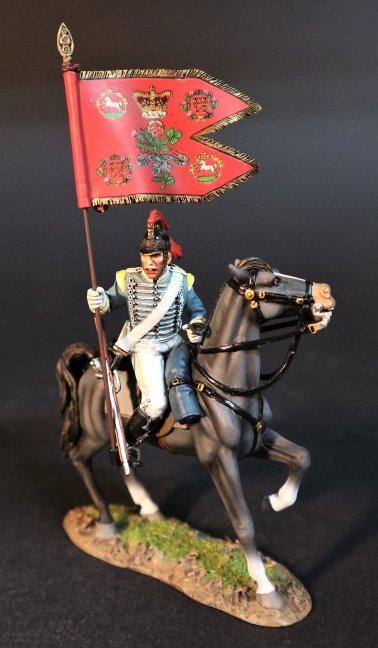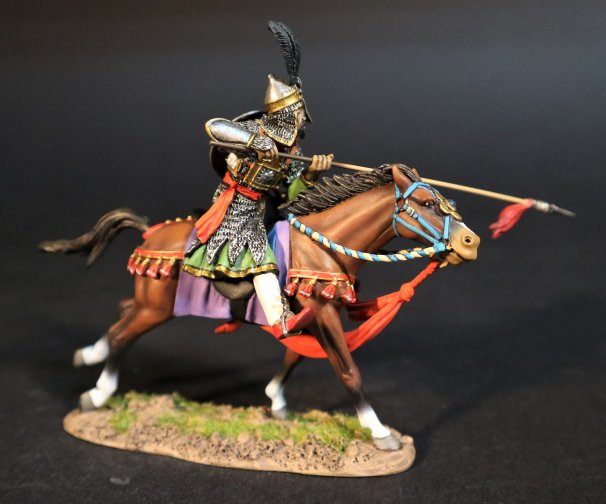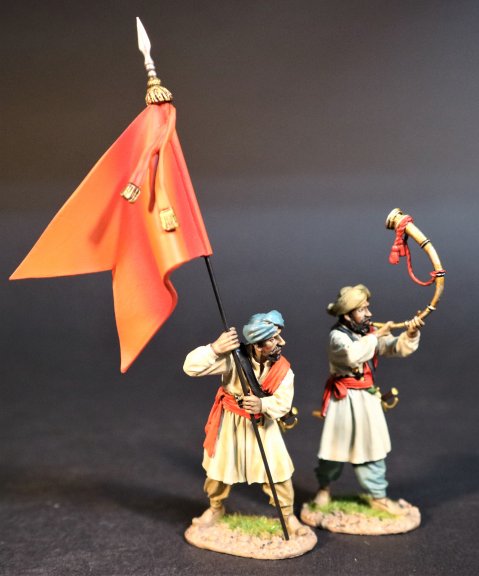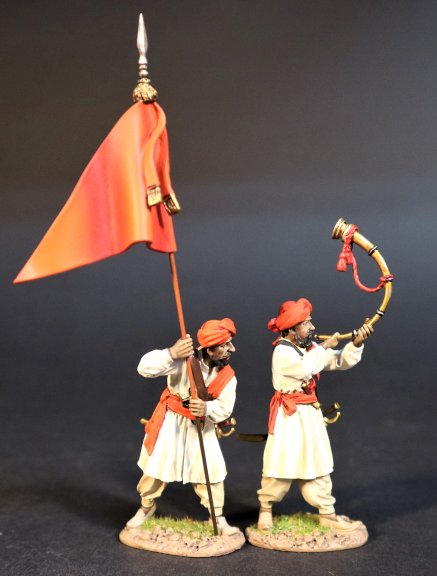- Joined
- Feb 2, 2011
- Messages
- 2,093
NEW RELEASES FOR SEPTEMBER 2022
WELLINGTON IN INDIA
THE BATTLE OF ASSAYE 1803
19[SUP]th[/SUP] REGIMENT OF LIGHT DRAGOONS
The 19[SUP]th[/SUP] Light Dragoons was a cavalry regiment of the British Army created in 1781 for service in British India. The regiment served in India until 1806, and in North America during the War of 1812. It was disbanded in Britain in 1821.

The regiment was raised by Colonel Sir John Burgoyne (a cousin of General John Burgoyne) as the 23[SUP]rd[/SUP] Regiment of Light Dragoons on 24[SUP]th[/SUP] September 1781 for service in India.
There had been no European cavalry to that date in India, and successive commanders there had called upon the regular British Army to supply a cavalry unit.
The regiment arrived at Fort St. George, Madras in 1782 and became the first British cavalry regiment to serve in India. In 1786 the regiment was renumbered as the 19[SUP]th[/SUP] Regiment of Light Dragoons
The 19[SUP]th[/SUP] played a major role in the Anglo-Mysore Wars, and Anglo-Maratha Wars.
Their first campaign was against Tipu Sultan of Mysore from 1790 to 1792. After defeating Tipu the 19[SUP]th[/SUP] were on garrison duty until 1799 when war broke out with Tipu again.
This time the Sultan was killed during the Siege of Seringapatam in May 1799.
In 1800, the 19[SUP]th[/SUP] fought Dhondia Wagh’s rebel army and in 1803, led by Major-General Arthur Wellesley they participated in the Battle of Assaye in September 1803. In this battle, the outnumbered British troops defeated a Maratha army and the regiment was subsequently awarded the battle honour of “Assaye” and presented with an honorary colour.
During the Battle of Assaye a formation of Maratha cavalry charged the 74[SUP]th[/SUP] Highland Regiment in the flank, and began capturing some of the British guns.
In response, Lt. Colonel Maxwell advanced with his cavalry brigade, which consisted of three regiments of Native Cavalry and the 19[SUP]th[/SUP] Light Dragoons, and charged the enemy’s left driving the Maratha cavalry into the river Juah, and from the field of battle.
The Maratha army was so large that the British rear was still threatened, so Maxwell’s cavalry returned to the rear, and ended the day with another charge against the Maratha infantry, even though the men and horses were exhausted.
In the initial pursuit of the Maratha cavalry Lt. Colonel Maxwell was killed.

WIN19-09
WELLINGTON IN INDIA,
THE BATTLE OF ASSAYE 1803,
19[SUP]th[/SUP] REGIMENT OF LIGHT DRAGOONS,
LIGHT DRAGOON STANDARD BEARER.
THE MARATHA EMPIRE
MARATHA CAVALRY
The Battle of Assaye was a major battle of the Second Anglo-Maratha War fought between the Maratha Empire and the British East India Company. It occurred on 23[SUP]rd[/SUP] September 1803 near Assaye in Western India where an outnumbered Indian and British force under the command of Major General Arthur Wellesley (who later became the Duke of Wellington) defeated a combined Maratha army of Daulatrao Scindia and the Bhonsle Raja of Berar.
The battle was the Duke of Wellington’s first major victory and the one he later described as his finest accomplishment on the battlefield, even more so than his famous victories in the Peninsular War and his defeat of Napoleon Bonaparte at the Battle of Waterloo.

The Maratha cavalry in the 1803 campaign was probably their weakest arm, yet by far the most numerous.
The Marathas employed three classes of cavalry.
The first were the BARGIRS, the cream of their cavalry, paid for and maintained by the state. At the death of Shivaji in 1680, they made up two thirds of the cavalry force, yet by the Battle of Panipat in 1761, their numbers had dropped to just 6,000 out of 38,000 cavalrymen.
This situation continued in the ealry years of the 19[SUP]th[/SUP] Century as the Marathas continued to put more emphasis on their regular infantry battalions.
The second type of cavalry were known as SILLIDARS, who were irregular cavalry and these men provided their own horses and weapons.

M-WIN-03
WELLINGTON IN INDIA,
THE BATTLE OF ASSAYE 1803,
THE MARATHA EMPIRE,
MARATHA CAVALRY
BARGIR CAVALRY.
The third type were known as PINDARRIES, and these were from various ethnic and religious backgrounds, with many being Muslims from the north.
Pindarries were an irregular light horse formation who were paid a fee or provided their retainers with a percentage, normally one sixth of any booty taken for the right to plunder.
They were used in the military role for screening the movement of troops, reconnaissance, raiding and cutting supply lines. They were not good against formations of steady infantry or cavalry, but were perfectly capable of cutting down unwary troops.
ARAB MERCENARY INFANTRY
The Battle of Assaye was a major battle of the Second Anglo-Maratha War fought between the Maratha Empire and the British East India Company. It occurred on 23[SUP]rd[/SUP] September 1803 near Assaye in Western India where an outnumbered Indian and British force under the command of Major General Arthur Wellesley (who later became the Duke of Wellington) defeated a combined Maratha army of Daulatrao Scindia and the Bhonsle Raja of Berar.
The battle was the Duke of Wellington’s first major victory and the one he later described as his finest accomplishment on the battlefield, even more so than his famous victories in the Peninsular War and his defeat of Napoleon Bonaparte at the Battle of Waterloo.
Kings, nobles and warlords have always imported mercenaries. Distrusting their own subjects, they placed faith on forces answering only to their benefactor. Through the ages, skilled and well-knit mercenary units have held inordinate power. Sometimes such units become so powerful that they turn on their employers on perceiving any threat. Sometimes, they even captured power. In India also, well-knit bands of Afghan, Turk, and African mercenaries have made great fortunes and captured power.
Arab mercenaries entered quite late in the game in India, when British supremacy had already emerged. Before the Arabs could expand their power in India — like so many foreign groups before them — their own benefactors and the British cut them down to size. However, their power and influence completely ended only in 1948.
The Sultans of Gujarat and the Deccan began employing Arab mercenaries in the 16th century. However, it was the Maratha campaigns of the 18th century that led to a huge influx. Arab mercenaries mostly hailed from Yemen’s Hadhramaut region, a land known for bold and enterprising people.
In the service of the Marathas, the Arabs gained reputation as extremely skilled and reliable fighters.
Thousands of Arabs served Maratha chieftains such as Scindia, Bhonsle and Gaekwad. Arab agents opened recruitment agencies in Indian ports, and some of these agents became very wealthy. Indian financiers also established ties with the Arabs to expand influence in Indian kingdoms.
Tribe and clan conflicts from the homeland existed in the mercenary units, but this did not dent their efficacy or their lustre.

M-WIN-20
WELLINGTON IN INDIA,
THE BATTLE OF ASSAYE 1803,
THE MARATHA EMPIRE,
MARATHA ARAB MERCENARIES
STANDARD BEARER AND MUSICIAN.
An Arab trooper was paid three times as much as a Deccani/Maratha trooper, and even more than a European mercenary.
However, their service depended entirely upon the regularity and size of the pay. When arrears mounted, the Arabs turned on their employers till they received their dues. In one instance, the Arab mercenaries even intervened in a political crisis in Baroda state. They imprisoned Maharaja Anandrao Gaekwad and his faction had to invite the East India Company’s army to retake control.
The British were aware of the threat posed by the Arab forces — and the Anglo-Maratha wars soon demonstrated how deadly Arab units could be.
When Britain finally concluded the Anglo-Maratha wars in 1818, she ensured that the Arab mercenaries were disbanded.
The British even paid the arrears so that the Arabs could leave immediately.
MARATHA INFANTRY

M-WIN-30
WELLINGTON IN INDIA,
THE BATTLE OF ASSAYE 1803,
THE MARATHA EMPIRE,
MARATHA INFANTRY
STANDARD BEARER AND MUSICIAN.
** PLEASE CONTACT YOUR LOCAL DEALER FOR FURTHER INFORMATION **
WELLINGTON IN INDIA
THE BATTLE OF ASSAYE 1803
19[SUP]th[/SUP] REGIMENT OF LIGHT DRAGOONS
The 19[SUP]th[/SUP] Light Dragoons was a cavalry regiment of the British Army created in 1781 for service in British India. The regiment served in India until 1806, and in North America during the War of 1812. It was disbanded in Britain in 1821.

The regiment was raised by Colonel Sir John Burgoyne (a cousin of General John Burgoyne) as the 23[SUP]rd[/SUP] Regiment of Light Dragoons on 24[SUP]th[/SUP] September 1781 for service in India.
There had been no European cavalry to that date in India, and successive commanders there had called upon the regular British Army to supply a cavalry unit.
The regiment arrived at Fort St. George, Madras in 1782 and became the first British cavalry regiment to serve in India. In 1786 the regiment was renumbered as the 19[SUP]th[/SUP] Regiment of Light Dragoons
The 19[SUP]th[/SUP] played a major role in the Anglo-Mysore Wars, and Anglo-Maratha Wars.
Their first campaign was against Tipu Sultan of Mysore from 1790 to 1792. After defeating Tipu the 19[SUP]th[/SUP] were on garrison duty until 1799 when war broke out with Tipu again.
This time the Sultan was killed during the Siege of Seringapatam in May 1799.
In 1800, the 19[SUP]th[/SUP] fought Dhondia Wagh’s rebel army and in 1803, led by Major-General Arthur Wellesley they participated in the Battle of Assaye in September 1803. In this battle, the outnumbered British troops defeated a Maratha army and the regiment was subsequently awarded the battle honour of “Assaye” and presented with an honorary colour.
During the Battle of Assaye a formation of Maratha cavalry charged the 74[SUP]th[/SUP] Highland Regiment in the flank, and began capturing some of the British guns.
In response, Lt. Colonel Maxwell advanced with his cavalry brigade, which consisted of three regiments of Native Cavalry and the 19[SUP]th[/SUP] Light Dragoons, and charged the enemy’s left driving the Maratha cavalry into the river Juah, and from the field of battle.
The Maratha army was so large that the British rear was still threatened, so Maxwell’s cavalry returned to the rear, and ended the day with another charge against the Maratha infantry, even though the men and horses were exhausted.
In the initial pursuit of the Maratha cavalry Lt. Colonel Maxwell was killed.

WIN19-09
WELLINGTON IN INDIA,
THE BATTLE OF ASSAYE 1803,
19[SUP]th[/SUP] REGIMENT OF LIGHT DRAGOONS,
LIGHT DRAGOON STANDARD BEARER.
THE MARATHA EMPIRE
MARATHA CAVALRY
The Battle of Assaye was a major battle of the Second Anglo-Maratha War fought between the Maratha Empire and the British East India Company. It occurred on 23[SUP]rd[/SUP] September 1803 near Assaye in Western India where an outnumbered Indian and British force under the command of Major General Arthur Wellesley (who later became the Duke of Wellington) defeated a combined Maratha army of Daulatrao Scindia and the Bhonsle Raja of Berar.
The battle was the Duke of Wellington’s first major victory and the one he later described as his finest accomplishment on the battlefield, even more so than his famous victories in the Peninsular War and his defeat of Napoleon Bonaparte at the Battle of Waterloo.

The Maratha cavalry in the 1803 campaign was probably their weakest arm, yet by far the most numerous.
The Marathas employed three classes of cavalry.
The first were the BARGIRS, the cream of their cavalry, paid for and maintained by the state. At the death of Shivaji in 1680, they made up two thirds of the cavalry force, yet by the Battle of Panipat in 1761, their numbers had dropped to just 6,000 out of 38,000 cavalrymen.
This situation continued in the ealry years of the 19[SUP]th[/SUP] Century as the Marathas continued to put more emphasis on their regular infantry battalions.
The second type of cavalry were known as SILLIDARS, who were irregular cavalry and these men provided their own horses and weapons.

M-WIN-03
WELLINGTON IN INDIA,
THE BATTLE OF ASSAYE 1803,
THE MARATHA EMPIRE,
MARATHA CAVALRY
BARGIR CAVALRY.
The third type were known as PINDARRIES, and these were from various ethnic and religious backgrounds, with many being Muslims from the north.
Pindarries were an irregular light horse formation who were paid a fee or provided their retainers with a percentage, normally one sixth of any booty taken for the right to plunder.
They were used in the military role for screening the movement of troops, reconnaissance, raiding and cutting supply lines. They were not good against formations of steady infantry or cavalry, but were perfectly capable of cutting down unwary troops.
ARAB MERCENARY INFANTRY
The Battle of Assaye was a major battle of the Second Anglo-Maratha War fought between the Maratha Empire and the British East India Company. It occurred on 23[SUP]rd[/SUP] September 1803 near Assaye in Western India where an outnumbered Indian and British force under the command of Major General Arthur Wellesley (who later became the Duke of Wellington) defeated a combined Maratha army of Daulatrao Scindia and the Bhonsle Raja of Berar.
The battle was the Duke of Wellington’s first major victory and the one he later described as his finest accomplishment on the battlefield, even more so than his famous victories in the Peninsular War and his defeat of Napoleon Bonaparte at the Battle of Waterloo.
Kings, nobles and warlords have always imported mercenaries. Distrusting their own subjects, they placed faith on forces answering only to their benefactor. Through the ages, skilled and well-knit mercenary units have held inordinate power. Sometimes such units become so powerful that they turn on their employers on perceiving any threat. Sometimes, they even captured power. In India also, well-knit bands of Afghan, Turk, and African mercenaries have made great fortunes and captured power.
Arab mercenaries entered quite late in the game in India, when British supremacy had already emerged. Before the Arabs could expand their power in India — like so many foreign groups before them — their own benefactors and the British cut them down to size. However, their power and influence completely ended only in 1948.
The Sultans of Gujarat and the Deccan began employing Arab mercenaries in the 16th century. However, it was the Maratha campaigns of the 18th century that led to a huge influx. Arab mercenaries mostly hailed from Yemen’s Hadhramaut region, a land known for bold and enterprising people.
In the service of the Marathas, the Arabs gained reputation as extremely skilled and reliable fighters.
Thousands of Arabs served Maratha chieftains such as Scindia, Bhonsle and Gaekwad. Arab agents opened recruitment agencies in Indian ports, and some of these agents became very wealthy. Indian financiers also established ties with the Arabs to expand influence in Indian kingdoms.
Tribe and clan conflicts from the homeland existed in the mercenary units, but this did not dent their efficacy or their lustre.

M-WIN-20
WELLINGTON IN INDIA,
THE BATTLE OF ASSAYE 1803,
THE MARATHA EMPIRE,
MARATHA ARAB MERCENARIES
STANDARD BEARER AND MUSICIAN.
An Arab trooper was paid three times as much as a Deccani/Maratha trooper, and even more than a European mercenary.
However, their service depended entirely upon the regularity and size of the pay. When arrears mounted, the Arabs turned on their employers till they received their dues. In one instance, the Arab mercenaries even intervened in a political crisis in Baroda state. They imprisoned Maharaja Anandrao Gaekwad and his faction had to invite the East India Company’s army to retake control.
The British were aware of the threat posed by the Arab forces — and the Anglo-Maratha wars soon demonstrated how deadly Arab units could be.
When Britain finally concluded the Anglo-Maratha wars in 1818, she ensured that the Arab mercenaries were disbanded.
The British even paid the arrears so that the Arabs could leave immediately.
MARATHA INFANTRY

M-WIN-30
WELLINGTON IN INDIA,
THE BATTLE OF ASSAYE 1803,
THE MARATHA EMPIRE,
MARATHA INFANTRY
STANDARD BEARER AND MUSICIAN.
** PLEASE CONTACT YOUR LOCAL DEALER FOR FURTHER INFORMATION **

